These days every major fitness tracker seems to have its own rating for an overall fitness level. For Strava they have two versions including a Fitness Score and a Freshness score. Here we’ll take a look at what the Strava Fitness Score can really measure, review what a good score is, and talk about how it can be used to improve your training.
First we need to point out that if you do not use Strava exclusively, there are a number of similar metrics from the other fitness trackers. The ones we’ve identified (and reviewed) include:
For the most part these tests all approximate the same thing, but their methods are different. Strava’s Fitness score is similar to some of these, and vastly different from others. In large part the name adds to the confusion, although “Fitness” seems objective what the score really measures is total training load.
This means that even people who are traditionally “Fit” may not have as high of a total score as others who simply log more time. It also means that the score is not aligned to your current potential. If you have been training hard for 2-3 months, and begin to taper in preparation for a big event, your score will drop even though you may feel and be able to preform better.
Strava Relative Effort & Fitness Score Impact
Strava uses a methodology of looking at the total effort expending and comparing it to your heart rate or past efforts. Each activity gets a “Relative Effort” score which is used to help build into your overall Fitness Score.
Because this can take into account your pace on a run or ride, as well as heart rate, it may not be uniform if you are widely varying terrain. Strava has some good data to have “Grade Adjusted Pace” but if you run the same course on two different days and one you are slogging through mud, slipping in the rain, and sweating profusely because of high temperatures and humidity the total time and HR might be significantly different than on a cool day on hard packed dirt.
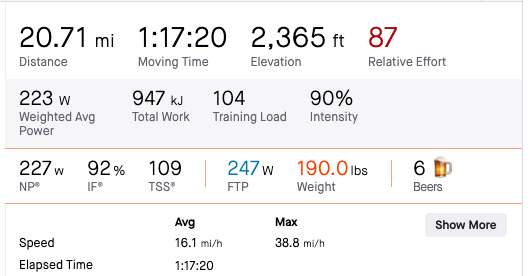
In these two scenarios each effort will produce a HR graph and different Relative Effort score that is used to shift the fitness score. Again, since Fitness is really training load, so the slower (longer) effort with a higher heart rate will actually raise a Fitness Score more.
Annoyingly, in the Fitness and Freshness graphs the relative effort is instead called “Training Load” and has a different value. It is only possible to see training load on an activity if you use one of the available Strava extensions. Rest assured though, even though the values are slightly different the general idea of Relative Effort and Training Load are the same.
Is Your Strava Fitness Score “Good”
A good fitness score is dependent on how much you are tracking within Strava. Comparing to others is very tough, as anyone who is doing longer and more frequent workouts will inherently have an advantage.
Also, if you are doing workouts that are not tracked in Strava there is noway to account for that impact. Of course everyone wants to know a rough chart of where fitness scores break out. Here is a non scientific summary of how to think about your fitness score and where it will line up, based on discussions with friends and a review of various forums and users.
Fitness Score 0-20: You may be new to Strava or track only occasional workouts. Some of them may not include heart rate data, or you may also not have setup settings to include age and weight. You workout 1-2 days a week but it is not at maximum capacity, especially compared to a few months/years ago (or really anything more than 45 days ago) so Strava knows you had the ability to push harder and your effort scores are trending down. You may be well rested and ready to start ramping up. You’re working on fitness.
Fitness Score 20-40: You workout 2-4 days a week with moderate activity. Most activities are under 45 minutes and the overall speed or intensity is lower. You may still be ramping up on and not have past 45 days of activity history logged. You are no couch potato, but can increase regular activity (or tracked regular activity).
Fitness Score 40-80: You regularly train, maybe up to 4-5 days a week. The intensity of some of these picks up, you occasionally get your heart rate into top zones and keep it there for a good portion of the run. You also may have a handful of big efforts, races or long rides/runs, in the recent past. You are consistent and may be on a training plan, but still balance with proper allotment of days rest. You are fit, but need to maintain good habits.
Fitness Score 80-120: You take training seriously. Even on your days “off” you likely still have some effort. There is some baseline level of activity that you regularly log, possibly a daily commute. You are likely to have a regular training plan including hard efforts and on a regular basis are logging efforts that are 60-90 minutes and likely have at least a once per week activity that is substantially longer. You’re fit.
Fitness Score 120+: You have a daily routine and it includes substantial time working out, running or cycling. You might be measuring training in total hours spent per week, and if so are likely to be in the 10+ hours range. A daily long commute helps, and in general your fitness is such that even long 60min efforts at 80-90% heart rate are still something you can routinely recover from. Everyone knows you are fit, it is a lifestyle for you.
With a few months of dedicated single sport design, it’s possible to get to a fitness score of 40-50. Most casual folks (those that are doing a Peloton ride 2-3 times a week) can expect a score from 20-35. Regardless the summary above is very rough so if you are not in the expected range do not worry.
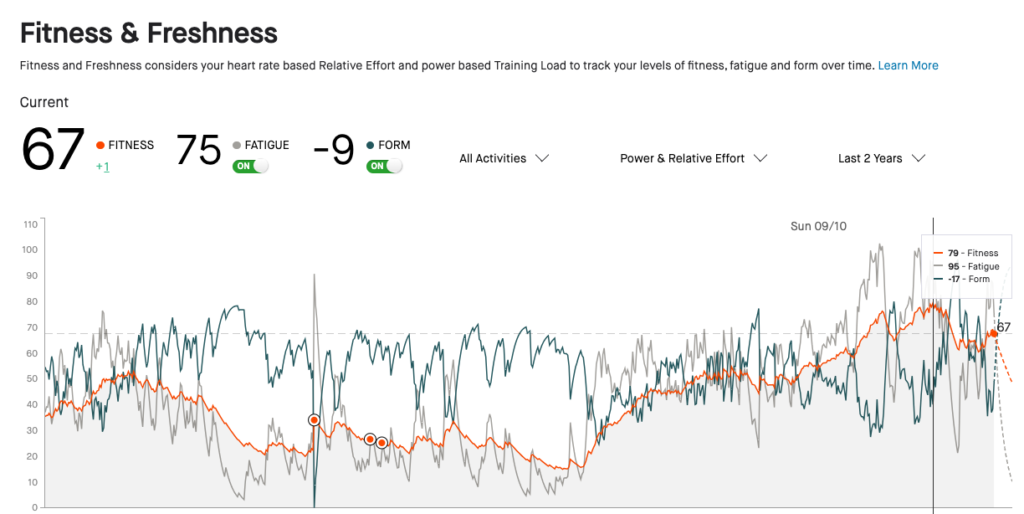
Thankfully a fitness score is not a one time measurement. The easiest way to improve your Strava fitness score is to stack your training load with hard efforts. In the above chart you can see a two year tracking of a fitness score. Note that even with 9 months of triathlon training, logging an average of 5-6 hours of training a week (and up to 8-10 for a few weeks) the highest overall score attained is still only 79.
What if your Fitness Score seems too high? If you do less work than some of the above, but still seem to have a high score, check that your max heart rate is set right in Strava. If it is not, the app may think that you are routinely doing max heart rate workouts and scoring as such.
What Is the Best Way To Quickly Improve A Strava Fitness Score
Even with all of the above training, the big spikes in Strava Fitness score all correlate to the hardest efforts on long races. Workouts that got tagged as “Historic Relative Effort” are linked to a shift in 5-10 points of total fitness score gains.

If you want to increase your Strava fitness score quickly, do it with a long hard efforts that is a historic relative effort.This effort above was an 18.5 mile run up and down a 3000ft peak. So it is not something that you can do everyday, but don’t expect to get a huge impact from short efforts.
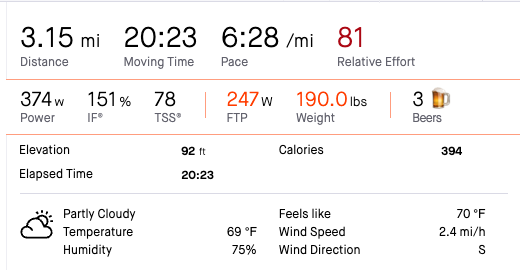
Even your fastest 5k run, at near max heart rate, is going to fall short of the relative effort of a long run. Take for example this PR level 5k. While the Relative Effort Score is high, especially given the time, it only impacted Fitness +1 point. This makes sense though since it is so much easier to recover from a hard 5k than it is from a nearly 3 hour marathon (even if one is much slower and at a lower heart rate).
How Much Can I Improve A Strava Fitness Score In a Run, Week, Month?
The fitness score impact of that single run (an 18+ mile, nearly 3 hour run) was +9 Fitness Score. To be fair this comes with a fair bit of freshness impact, another number which Strava tracks. That same run moved a Freshness from 56 to 110, and personally it was not a run that I could do on back to back days, or really even back to back weekends without ideally. Some others have shared that they were able to move a score by up to +18 from a long 4+ hour effort on a low base.
On a hard 20 minute 5k effort I was also able to improve my Fitness score by +4. This was at nearly max heart rate, with 95% of the run spent at 90+% max heart rate. A standard daily run of anywhere from 20-60 minutes usually only moves a fitness score by +1 and some short easy runs do not move it at all.
Again because Fitness Score is cumulative there is also concern about how much it drops. The model seems to be that for each day where you do not log a workout that Fitness Score will be -1.
Given all of this, along with actual observation, it seems possible to improve a Strava Fitness score by +7 to +14 in a given week with little to no rest. Over the course of a month this level may be harder to sustain although +30-+40 in a month is not out of the question. This is assuming you are coming into the week very fresh, and for the most part have been under reporting your training in Strava. For those with an existing Fitness Score it may be harder to add this on, while anyone coming to Strava for the first time and with some workout experience is better suited for a quick start.
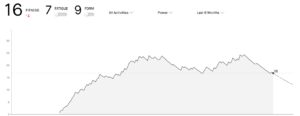
This final chart shows just a power based fitness chart. Coming from never tracking rides with power in Strava I was able to build to a +17 Fitness score within one month of 2-3 days a week of Peloton rides. Another month at the same produced a rating of +27 maximium. After that the rating even out as it my standard cadence would be one or two days off (resulting in -2) and then a day of riding (+1 to +3). The combined Power+Relative Effort scores are higher than this by about 20 points, but that is do to alternating days of running with days of riding.
Want to get the most out of Strava? Check out our list of top Strava add ons to maximize your fun and data insights, including other metrics to track fitness, freshness, and fatigue.
Compare Strava Fitness Score To Other Cardio and Training Measures
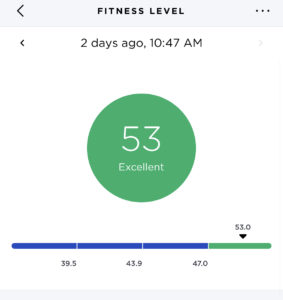
Health Mate Fitness Level
Using the Withings app and devices to approximate your “fitness” by using a combination of V0@ max and weight. Read how it compares to Strava fitness score and other train load measures. “
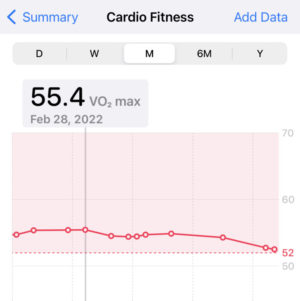
Apple V02 Max
Integrated with Apple Health kit and Apple products, V02 max is a measure of cardio fitness (not training load). Read how V02 max measures up against the Strava Fitness Score.